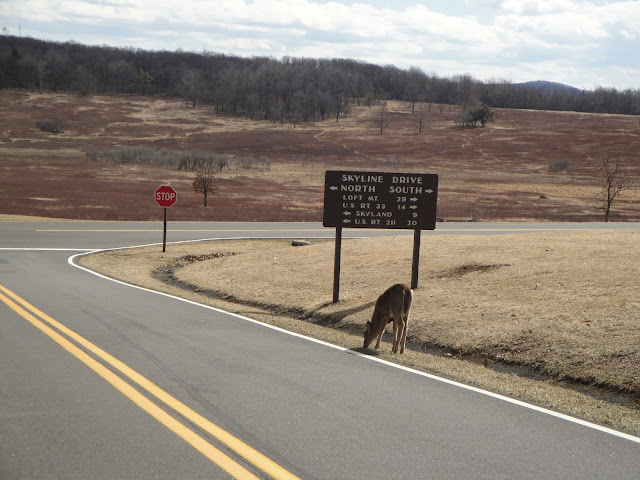Option 1, "Winter Hawks" sounded promising until I discovered that all of the recommended spots were prohibitively far away. Option 2, "Tracking" seemed a little too general and unexciting for my purposes. Options 3 and 4 were titled "Lake Eerie Steelhead," and "Exploring Winter Beaches," respectively - both of which were also out because of travel time. The final option, "Pelagic Birding Trips," sounded fascinating but requires much more organization than I had the time or inclination to put together. Frankly, I had to look up the word 'pelagic' anyway.
February Event: Tracking
 |
| My choice of a human footprint here doesn't mean I failed entirely... |
The Location
I have repeatedly talked about this place, and I'm sure it will come up over and over again in this blog. So I won't bore you with redundancies (except in link form). Looking back, though, it's hard to believe I only have one post solely about Shenandoah.
Why there, and Why then?
 | |
| Well, the guide was right about one thing. There was definitely snow. |
The Trip, and What I Learned
Like the previous trip, this one was wonderful. Unfortunately I didn't learn much about tracking - I relied on a few things I already know and just enjoyed getting a good hike in in February. We got to the park pretty early, and chose one of our favorite spots: Mary's Rock. (There are those ulterior motives again). The last time we had done this hike was in the hottest part of the summer, so it was a nice change of pace (and still gorgeous) to hike it with a dusting of snow. What's nice about this hike is that although steep, it's less than a two-mile trip from the parking lot to the summit. And the view is spectacular.
 |
| The trailhead - per the sign, much of this hike is on the Appalachian Trail. |
 |
| We thought this was beautiful - a veritable explosion of color amid the white, gray, and brown. |
I have a couple of decent photos of the view from Mary's Rock itself, but I don't feel they do it justice. If you follow the link above there are a couple that almost get the job done, but it's one of those things you just have to see to appreciate fully. Luckily for DC denizens, it's not too far away and you don't have to be a marathon runner to pull off the climb.
When we were finished with that hike, we decided to make a quick stop at one of the park's other notable spots, Big Meadows. As usual, there were quite a few deer nearby (and signs of other fauna, which I'll get to). I have to say, though, that Big Meadows is pretty drab in the dead of winter. There's still a certain beauty to the place, and I'm glad I have seen it in its more dormant state, but I wouldn't put it at the top of my list for winter outings.
 |
| My guess is these were left by a squirrel. But it's hard to be certain without a clear footprint. |
 |
| Deer poop |
A couple of other signs of note were some loose feathers, and some obvious groundhog trails. Photos of those are even more boring than photos of poop, though, so I'll let it go.
When tracking, what a good naturalist is really after is not just an identity of what had passed this way, but a story of what it was doing and why. If the deer tracks are clustered in one muddy spot, what made them behave this way? Was it a predator? A mating display or fight for dominance? If there's loose fur, did the owner just get snagged on a twig or was there some sort of conflict? How recent are the tracks you're looking at? Was the animal moving quickly or slowly? One thing I noticed was that some of the deer scat was clustered into piles, while other spots were scattered. This led me to wonder why those particular deer were exhibiting divergent restroom behaviors. It's this type of question that can turn one from aware of nature's signs to an expert at interpreting them. Myself, I'm somewhere in between... I know how to ask the questions but not often how to answer them. Good guides on tracking do exist, though I can't offer much in the way of critique. If you're interested in learning how to track and "read sign" I suggest that you research these and select one... but it's really the experience that will teach you. I will leave you with my favorite deer picture from the day.
 |
| This young buck is showing his antler velvet... I've never managed a clear photo of this before, so I'll call it a win. |

I would hardly call this February a dismal month. :-)
ReplyDeleteAnd it never will be again, right? I revel in my own genius.
DeleteThe term 'divergent restroom behaviors' really made this entire post worth the read.
ReplyDelete